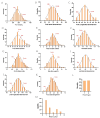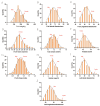Phenotypic Characters and Inheritance Tendency of Agronomic Traits in F1 Progeny of Pear
- PMID: 40431056
- PMCID: PMC12115335
- DOI: 10.3390/plants14101491
Phenotypic Characters and Inheritance Tendency of Agronomic Traits in F1 Progeny of Pear
Abstract
Studying fruit genetic trends, heterosis, and growth traits in pear hybrid progeny provides the foundation for variety breeding. The aim of this research is to reveal the trait performance of the hybrid progeny of Chinese white pear and Western pear and provide a theoretical basis for other breeders to predict the trait performance of their hybrid progeny when selecting Eastern pear and Western pear as parents. Our research team constructed a 'Yuluxiang' × 'Xianghongli' interspecific hybrid population in 2015, and in 2023, we conducted a two-year investigation of 16 traits in 140 hybrid progeny, including 11 fruit traits and 5 growth traits, and analyzed and compared the genetic variation and heterosis of traits, as well as the correlation between various traits. The results showed that the hybrid progeny was widely segregated for single fruit weight (FW), soluble solid (SS) content, and titratable acid (TA) content and conformed to a normal distribution, with quantitative genetic traits under polygenic control. The highest two-year coefficients of variation for TA were 54.42% in 2023 and 39.17% in 2024. A genetic trend of decreasing FW was observed, which was greatly influenced by the male sex. The ratio of soft soluble flesh to crispy flesh was 1:1, and the gene controlling this trait may be a quality trait controlled by a single gene. The traits that showed transgressive heterosis for two years included fruit longitudinal diameter (FLoD), fruit shape index (FSI), and TA, and those that showed negative heterosis included FW, SS, leaf longitudinal diameter (LLoD), and leaf lateral diameter (LLaD). Correlation analysis indicated that the progeny of crosses in this combination, which had red fruit skin, may also present red early flowering color (EFC) and young leaf color (YLC), reddish brown annual branch color (ABC), and lower FSI, fruit stalk length (FSL), LLaD, and TA. Thus, at the seedling stage, individuals with red-colored fruit may be screened by observing the color of young leaves and young stems and the lateral diameter of the leaves. Principal component analysis showed that among the 16 traits included in six principal components, peel color (PC), FLoD, 2024SS, fruit tape (FT), and FSI were the main factors causing differences in fruit phenotypes. This study systematically elucidated the genetic trends of agronomic traits in pears and will provide a theoretical basis for the selection of parents and early selection of hybrid progeny in pear hybrid breeding.
Keywords: fruit traits; genetic variation; hybrid progeny; pear.
Conflict of interest statement
The manuscript is approved by all authors for publication, and no conflicts of interest exist in the submission. We would like to declare that the work carried out by all authors listed is original and has not been published in any form previously. All authors listed have contributed significantly to the work and agree to be in the author list.
Figures






Similar articles
-
Variation analysis and comparison of leaf and fruit traits of triploid hybrid progeny in jujube.Front Plant Sci. 2025 Mar 7;16:1553316. doi: 10.3389/fpls.2025.1553316. eCollection 2025. Front Plant Sci. 2025. PMID: 40123953 Free PMC article.
-
Haplotype-resolved T2T genome assemblies and pangenome graph of pear reveal diverse patterns of allele-specific expression and the genomic basis of fruit quality traits.Plant Commun. 2024 Oct 14;5(10):101000. doi: 10.1016/j.xplc.2024.101000. Epub 2024 Jun 10. Plant Commun. 2024. PMID: 38859586 Free PMC article.
-
Evaluation of the Effect of Preharvest Melatonin Spraying on Fruit Quality of 'Yuluxiang' Pear Based on Principal Component Analysis.Foods. 2023 Sep 21;12(18):3507. doi: 10.3390/foods12183507. Foods. 2023. PMID: 37761217 Free PMC article.
-
Evaluation on the phenotypic diversity of Calamansi (Citrus microcarpa) germplasm in Hainan island.Sci Rep. 2022 Jan 10;12(1):371. doi: 10.1038/s41598-021-03775-x. Sci Rep. 2022. PMID: 35013363 Free PMC article.
-
Development and characterization of a strawberry MAGIC population derived from crosses with six strawberry cultivars.Breed Sci. 2017 Sep;67(4):370-381. doi: 10.1270/jsbbs.17009. Epub 2017 Aug 4. Breed Sci. 2017. PMID: 29085247 Free PMC article.
References
-
- Huang C., Yu B., Teng Y., Su J., Shu Q., Cheng Z. Effects of fruit bagging on coloring and related physiology, and qualities of red Chinese sand pears during fruit maturation. Sci. Hortic. 2009;121:149–158. doi: 10.1016/j.scienta.2009.01.031. - DOI
-
- Qin M.F., Li L.T., Singh J., Sun M.Y., Bai B., Li S.W., Ni J.P., Zhang J.Y., Zhang X., Wei W.L., et al. Construction of a high-density bin-map and identification of fruit quality-related quantitative trait loci and functional genes in pear. Hortic. Res. 2022;9:uhac141. doi: 10.1093/hr/uhac141. - DOI - PMC - PubMed
-
- Wang F., Ou C.Q., Zhang Y.J., Ma L., Jiang S.F. A New Red and Crisp Pear Cultivar ‘Huatong’. Acta Hortic. Sin. 2024;51:31–32.
Grants and funding
LinkOut - more resources
Full Text Sources

